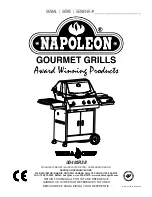
14
H9. Turning Off Your Barbecue
When you have finished using your barbecue,
turn all the control valves fully clockwise to the
“Off” position, then switch off the gas at the
bottle. Wait until the barbecue is sufficiently
cool before closing its lid.
I. Care and Maintenance
Regularly clean your barbecue between uses
and especially after extended periods of
storage. Ensure the barbecue and its
components are sufficiently cool before
cleaning. Do not leave the barbecue exposed
to outside weather conditions or stored in
damp, moist areas.
n
Never douse the barbecue with water
when its surfaces are hot.
n
Never handle hot parts with unprotected
hands.
In order to extend the life and maintain the
condition of your barbecue, we strongly
recommend that the unit be covered when left
outside for any length of time, especially
during the winter months. Heavy-duty
Outback® barbecue covers and other
accessories are available from your local
Outback® stockist.
Even when your barbecue is covered for its
protection, it must be inspected on a regular
basis as damp or condensation can form
which may result in damage to the barbecue.
It may be necessary to dry the barbecue and
the inside of the cover. Any rust that is found
that does not come into contact with the food
should be treated with a rust inhibitor and
painted with barbecue paint or a heat resistant
paint. Wooden parts may also need to be
cleaned and re oiled. Chrome plated warming
racks etc. should be coated with cooking oil.
I1. Porcelain Coated Cast Iron Cooking
Surfaces
Enamel is a thin, glass based coating fused
onto metal and as such needs to be treated
with care Cooking oil, together with fat from
food being cooked can turn to carbon as a
result of heating and result in black flakes
coming away from the cooking surfaces.
These are not harmful. Porcelain should be
cleaned using hot soapy water or with the use
a suitable cleaning product following the
manufactures instructions. Due to the weight
of the grills and griddle, we do not recommend
cleaning in a dishwasher.
I2. Burner Removal
Your burners have been preset for optimal
flame performance. You will normally see a
blue flame, possibly with a small yellow tip
when the burner is alight. If the flame pattern
is significantly yellow, this could be a problem
caused by grease from cooking blocking the
burner or spiders or other insects in the burner
venturi. This can result in the flow of the gas
and air mixture being restricted or blocked
which may result in a fire behind the control
panel causing serious damage to your
barbecue.
If this happens, the gas should
be immediately turned off at the bottle.
Burners should be inspected and cleaned on
a regular basis in addition to the following
conditions:
•
Bringing the barbecue out of storage.
•
One or more of the burners do not ignite.
•
The burner flame pattern is significantly
yellow.
•
The gas ignites behind the control panel.
To clean a burner, remove it from the
barbecue. It is quite normal for a cast iron
burner to rust. The outside of the burner can
be cleaned with a wire brush.
Clean the portholes with a pipe cleaner or
piece of wire. Take care not to enlarge the
portholes.
Clean the insect screen on the end of the
venturi tube with a bristle brush (i.e. an old
toothbrush).
Clean the venturi tube with a pipe cleaner or
piece of wire. You may need a torch to see
into the venturi tube to make sure it is clear.
You will see a pin inside the tube which is part
of the burner assembly.
Turn the burner up on end and lightly tap
against a piece of wood to dislodge any debris
from inside.




































